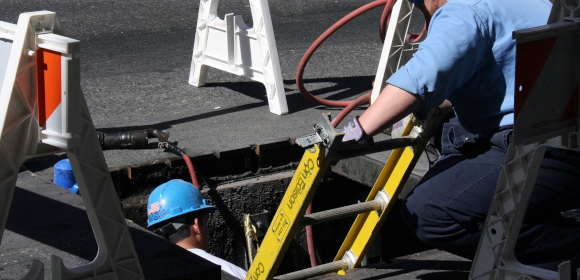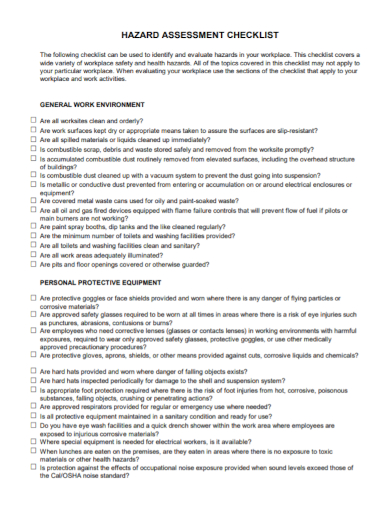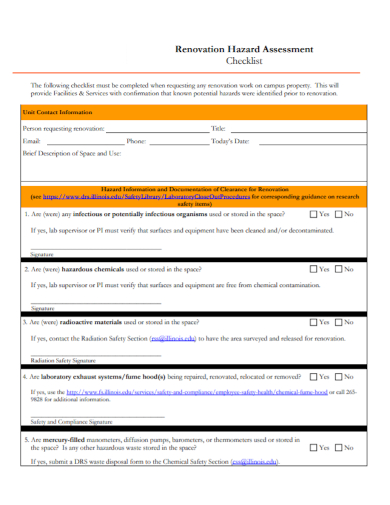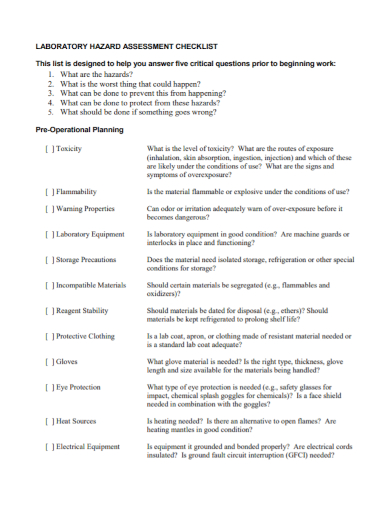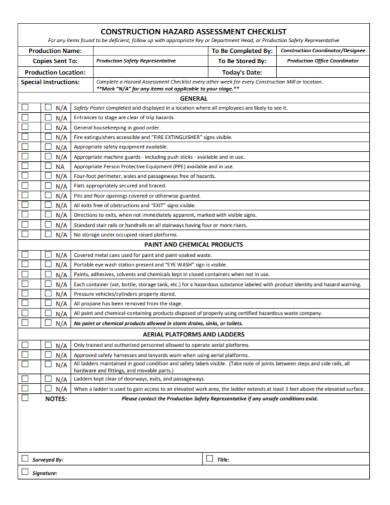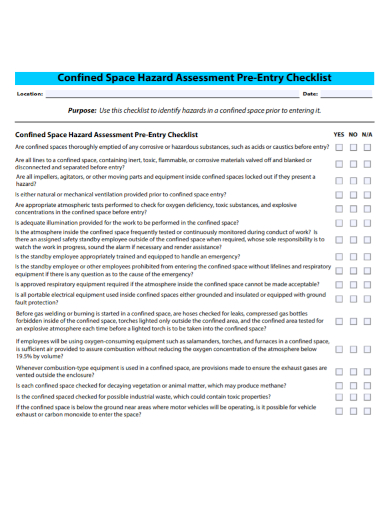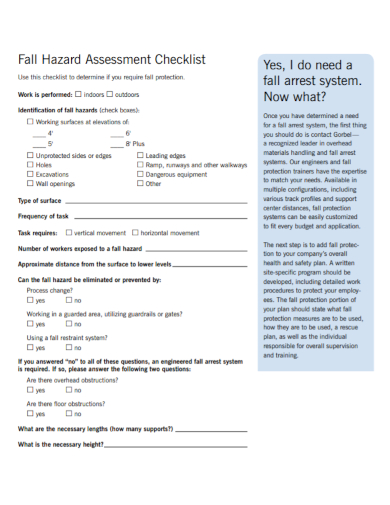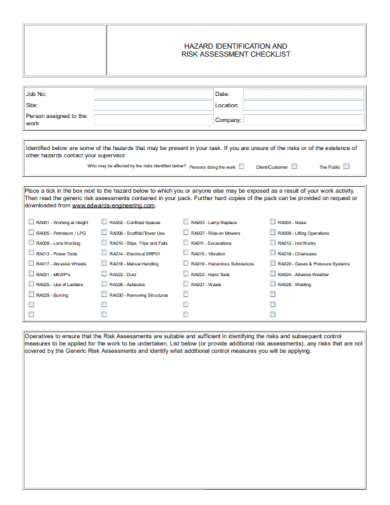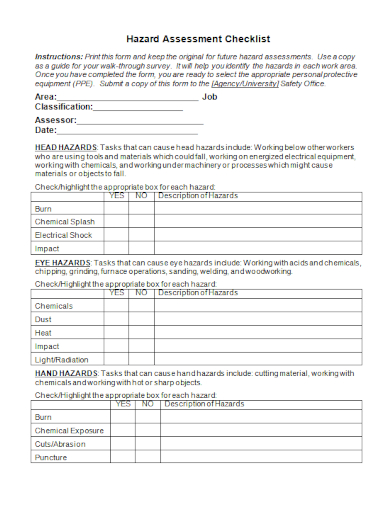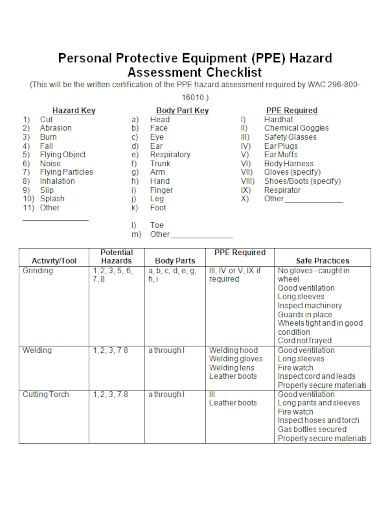10+ Hazard Assessment Checklist Samples
“Prevention is better than cure.” This is a constant phrase while putting in place safeguards against risks and dangers. The first step in preventing risks in your house is to be aware of them. Fire, poisoning, and allergy are just a few of the most common home dangers. Other potential causes can be falls, choking, wounds, and burns. If you’re looking to strengthening your precautionary and preparatory measures for various risks and emergency situations, look no further. In this article, we provide free and ready-to-use samples of Hazard Assessment Checklists that you could use in order to plan and protect yourself from these sorts of unfortunate events. Keep on reading to find out more!
1. Hazard Assessment Checklist
2. Renovation Hazard Assessment Checklist
3. Hazard Evaluation Assessment Checklist
4. Laboratory Hazard Assessment Checklist
5. Construction Hazard Assessment Checklist
6. Hazard Assessment Pre-Entry Checklist
7. Hazard Risk Assessment Checklist
8. Fall Hazard Assessment Checklist
9. Hazard Identification Assessment Checklist
10. Sample Hazard Assessment Checklist
11. Equipment Hazard Assessment Checklist
What Is a Hazard Assessment Checklist?
The process of identifying, assessing, and controlling hazards within a property and threats to health and safety is known as hazard assessment. Any scenario, thing, or condition that exposes a person to the risk of injury or occupational sickness is referred to as a hazard. A hazard assessment checklist, often called a hazard assessment form, is a tool that safety officers use to conduct danger assessments. By identifying potential hazards and describing how the risks will be addressed, hazard assessments aid in the prevention of injuries and diseases. Government safety regulations necessitate hazard assessments. In the workplace, failure to keep track of dangers and safeguard people from injury or illness might result in costly legal action.
How to Make a Hazard Assessment Checklist
The goal of a hazard assessment is to identify potential risks and hazards in the region, as well as appropriate safety measures to reduce the threats that have been discovered. The checklist can vary depending on the area, for instance, a building hazard assessment can have different requirements in comparison with a workplace hazard assessment. Despite that, you can still use the free templates provided above. If you’re interested in making a checklist that is specific to your area, here are the following general components that comprises a Hazard Assessment Checklist to guide you in drafting one of your own:
1. Determine the dangers.
To begin your checklist, figure out the breadth of the job you’ll be evaluating. Take a walk around your location and search for anything that could potentially cause injury. Check the instructions or data sheets for chemicals and equipment from the manufacturer, since they may be very helpful in laying out the risks and putting them into context.
2. Examine who might be hurt and how they might be harmed.
You should be clear about who might be harmed by each hazard; this will help you determine the best method to manage the risk. This does not mean naming everyone; rather, it means recognizing groupings of people.
3. Assess the dangers and take precautions if necessary.
This will allow you to prioritize your actions and ensure that your resources are allocated appropriately. When it comes to precautions, you should think about them in the following order, rather than going to the first option that comes to mind. Personal protective equipment should be your last resort, with measures that protect more than one person taking precedence. Improving health and safety does not have to be expensive. If an accident occurs, failing to take simple safeguards could cost you a lot more.
4. Review and update your risk assessment as needed.
You should check your risk assessments on a frequent basis to ensure that they are still valid. It is suggested that you evaluate them once a year at the very least. Between the time you conduct your risk assessment and the time it is completed, things are likely to change. After an accident or near-miss, it’s critical to revisit your risk assessment. This may assist in preventing them from occurring again.
FAQ
What are the benefits of identifying hazards?
The effects and/or possibility of disease, injury, and death are decreased by recognizing the hazards, analyzing the risks involved, and then managing or eliminating these risks.
What are the most significant aspects of hazard analysis?
People, Environment, Materials, and Equipment are the four major components of any hazard assessment checklist. To determine what dangers are present, all four components must be reviewed during a hazard assessment.
What are the four fundamental approaches of hazard control?
Hazard control needs the application of four basic measures, as applicable to the situation: engineering controls, administrative arrangements, safe work practices, preventative maintenance, and the use of personal protective equipment.
All in all, a hazard assessment checklist ensures the safety of the people in the area. This also helps you mitigate any plausible emergency situations by checking out possible causes of it. To help you start, download our easily customizable and printable samples of Hazard Assessment Checklists to know what safety measures and precautions are needed to be set in place in your area.
Related Posts
FREE 11+ Freelancer Checklist Samples in MS Word | Google Docs | PDF
FREE 23+ Party Checklist Samples in MS Word | Google Docs | Apple Pages | PDF
FREE 18+ Scheduling Checklist Samples in MS Word | Google Sheets | PDF
FREE 17+ Response Checklist Samples in MS Word | Google Docs | PDF
FREE 17+ Survey Checklist Samples in MS Word | Google Docs | PDF
FREE 18+ Background Checklist Samples in MS Word | Google Sheets | PDF
FREE 18+ Facilitator Checklist Samples in MS Word | Google Sheets | PDF
FREE 18+ Complaint Checklist Samples in MS Word | Google Sheets | PDF
FREE 18+ Internship Checklist Samples in MS Word | Google Docs | PDF
FREE 18+ Statement Checklist Samples in MS Word | Google Sheets | PDF
FREE 20+ Voluntary Checklist Samples in MS Word | Google Sheets | PDF
FREE 18+ Summary Checklist Samples in MS Word | Google Sheets | PDF
FREE 14+ Sponsorship Checklist Samples in MS Word | MS Excel | PDF
FREE 18+ Conference Checklist Samples in MS Word | Google Sheets | PDF
FREE 17+ Lesson Checklist Samples in MS Word | Google Sheets | PDF
